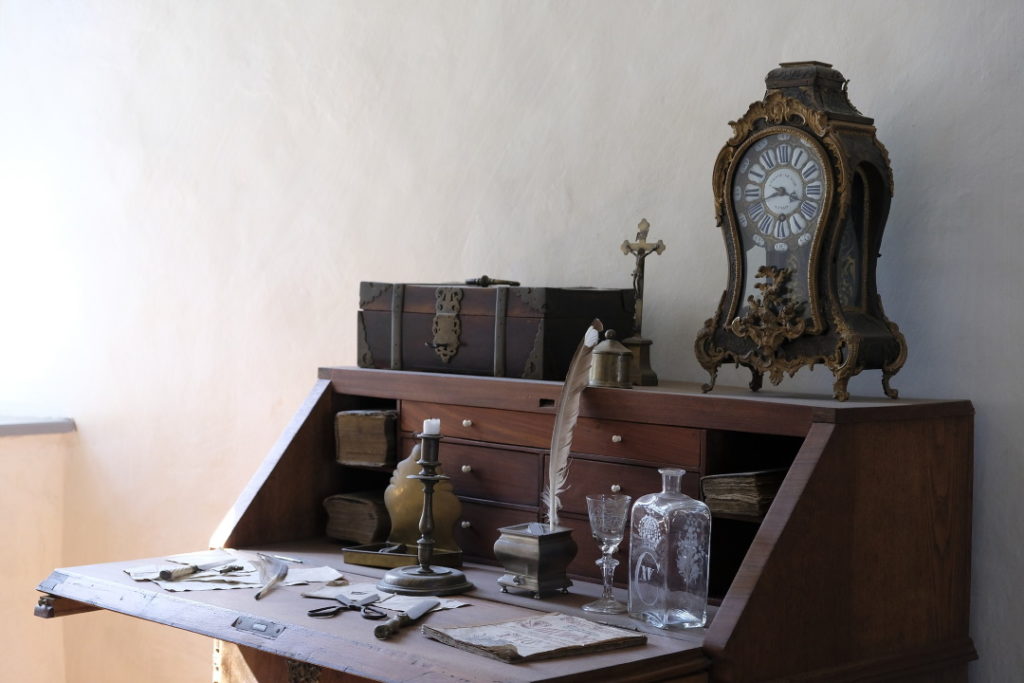I’ve spent a lot of time this past summer sorting through boxes in my garage and garment bags in my closet, many of which have not been touched since we moved in seventeen years ago. With all the things I’ve unearthed have come a deluge of memories and emotions.
There have also been a lot of phone calls to my mother, and hard decisions I’ve had to make. Do I really need to keep these two marble-topped end tables just because they belonged to my grandmother, even though they’ve been unused for at least a decade?

My mother’s advice has remained constant: “Those are your things. If you don’t want them, sell them or donate them. You don’t have to feel guilty because they don’t fit your style anymore.”
But more than just seeking permission to part with belongings that came from a house I haven’t seen since 1991 is the reason I have them in the first place: after my grandfather died, my grandmother moved in with my parents. Grandma had two other living daughters, and my mother was neither the oldest nor the youngest, but she had the space and the flexibility. And, in truth, she had me close by to give her a respite when she needed one.
The grandmother clock (smaller than a grandfather clock) was a gift from my grandfather to his wife for a birthday. On its own, it’s nothing special. It’s just a piece of furniture from Sears. But it represents the joy in my grandmother’s voice when she would gush over it. “It plays the Westminster Chimes,” she would announce. “Listen.” And then she’d sing along with the bells. It stood in my mother’s house until she moved to Mexico. Now it guards my front door.
The red leather wing chair in my studio was my grandfather’s reading chair when I was a baby. I remember it surrounded by piles of National Geographic and Model Railroader magazines. It lived in my grandmother’s bedroom at my mother’s, where she would sit and read. Now it’s mine, but two moves across the country have marred it: there’s a long slash in one side, that I hide by keeping it in a corner. As well, the seat is sagging. I’ve thought about repairing it, but it would cost more than the real value of the chair.
When it comes to getting rid of my own things, I’m ruthless. “That entertainment center has been in the garage for a decade and doesn’t fit any of our TVs. We’re not moving it.”
My husband, who is more of a packrat than I am, reluctantly agrees that we don’t need to pack and move items we really haven’t used. But he shares my hesitation about the stuff that came from family.
It’s a dilemma we all have as the people we love age, move out of their homes and into ours (or care homes) and eventually die. On the one hand, those family treasures are imbued with a ton of meaning. On the other, they’re just things, and keeping a clock or a table or even my stepfather’s collection of science and math textbooks doesn’t make my memories any stronger, just as donating or selling these things won’t diminish them.
For years, we joked about my grandmother encouraging us to walk around her house and put post-its on the back of things we loved. But tastes change and needs change. There was no way, at twenty-one, that I had a place to put a baby grand piano, even though it was meant for me, so it went to one of my cousins when we moved her into a senior living apartment.
Now, the things that I have are a mishmash of Grandma’s and Grandpop’s things. Fishing rods and ancient tool chests, a dress she wore as a bridesmaid in the 40s, a stray uniform had and all of his service pins, the clock, the chair, and the tables.
Intellectually, I know that letting these things go to people who will use them isn’t a betrayal of memory. My grandparents would never want me to feel guilty. But emotionally, I’m not quite there yet.
Soon, I will be.
